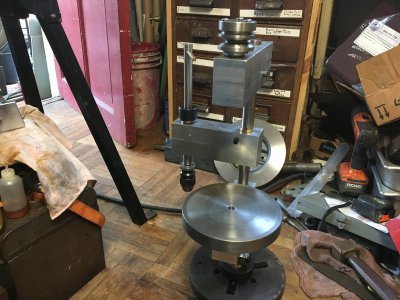- Joined
- Dec 18, 2019
- Messages
- 7,638
Sad to say, I have stalled on this project. The issue I ran into was my drill press had terrible runout. And I apparently had issues with the drill chuck as well, compounding the problem. Oh, and not all of my drill bits were true. (But I didn't realize this at the time.) So when I used the drill sizes recommended by Mikey, the resultant holes were larger than the reamer diameter! I really followed his instructions very carefully, but apparently his equipment was far superior to mine. I hadn't accounted for that at all. This was quite discouraging.
I looked at rebuilding the drill press and decided against it - as I'd just end up with a slightly better but low end drill press. So the dark forces took over and I ended up buying a PM25MV mill. Can't say I regret my purchase one bit. I was able to transfer over my LED spindle light I had made for the drill press directly over to my mill, so was happy about that.
I should finish this knurler, as it would be quite useful to me. But in truth, it wouldn't be very faithful to the title. However, I can continue this thread. You can find Mikey's thread at A Straddle Knurler for the Sherline Lathe Hope to be posting on this further in the new year. A while back all the project bits were gathered to one area, but now I have to find that area, and assess what I need to do next.
I looked at rebuilding the drill press and decided against it - as I'd just end up with a slightly better but low end drill press. So the dark forces took over and I ended up buying a PM25MV mill. Can't say I regret my purchase one bit. I was able to transfer over my LED spindle light I had made for the drill press directly over to my mill, so was happy about that.
I should finish this knurler, as it would be quite useful to me. But in truth, it wouldn't be very faithful to the title. However, I can continue this thread. You can find Mikey's thread at A Straddle Knurler for the Sherline Lathe Hope to be posting on this further in the new year. A while back all the project bits were gathered to one area, but now I have to find that area, and assess what I need to do next.

 This lost the registration of the top arm to the bottom. Fortunately the bottom piece hadn't moved so I drilled it. Then I opened the vise and put in the top arm again. I used a piece of rod that I measured to be 0.2495" as a locating pin in the 0.2500 hole. Then clamped it in the vise and checked that the other hole was ok. I used the #14 drill and was able to push it all the way through. The #13 drill seemed to not cut as much as the D drill had. Finally reamed it to 0.1875". I took a 0.1875" M2 rod and (after I lined it up correctly) was able to slowly push it all the way through both arms.
This lost the registration of the top arm to the bottom. Fortunately the bottom piece hadn't moved so I drilled it. Then I opened the vise and put in the top arm again. I used a piece of rod that I measured to be 0.2495" as a locating pin in the 0.2500 hole. Then clamped it in the vise and checked that the other hole was ok. I used the #14 drill and was able to push it all the way through. The #13 drill seemed to not cut as much as the D drill had. Finally reamed it to 0.1875". I took a 0.1875" M2 rod and (after I lined it up correctly) was able to slowly push it all the way through both arms.



